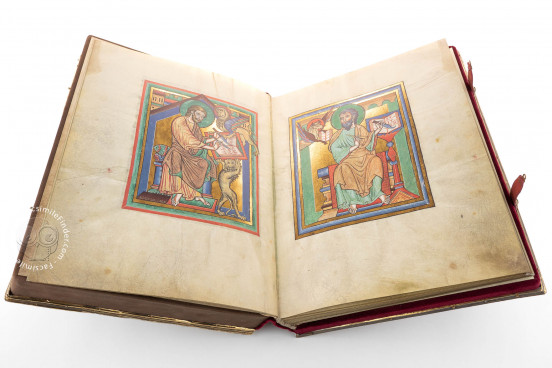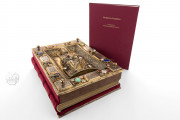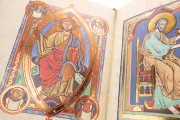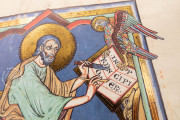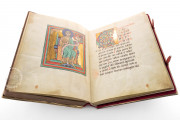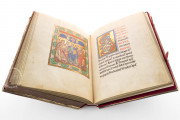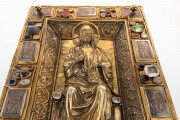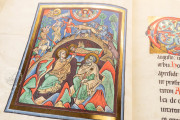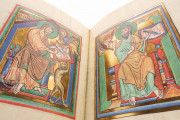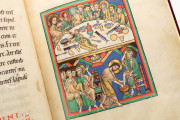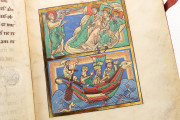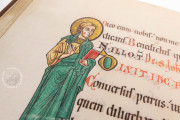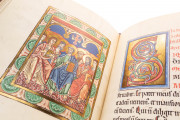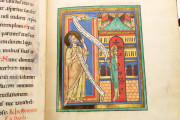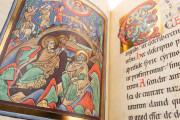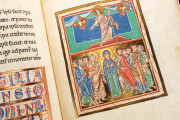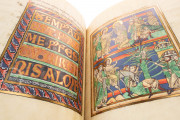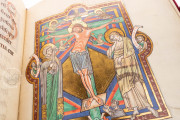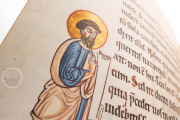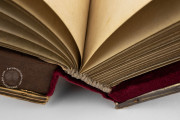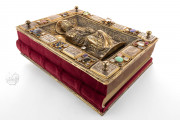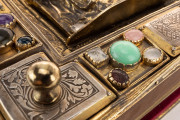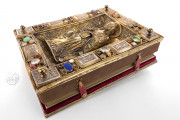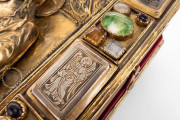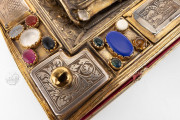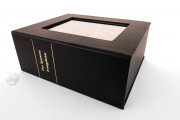The Speyer Pericopes—or Speyer Evangelistary—is a Christian liturgical manuscript produced around 1220 in southwestern Germany. It contains select passages from the Gospels for reading at Mass, arranged in liturgical order, beginning with Christmas Eve. The manuscript opens with a monumental image of Christ in Majesty surrounded by the evangelists' symbols. Equally sumptuous full-page portraits of the evangelists follow, and the readings are illustrated by an additional twelve full-page miniatures. The manuscript originally belonged to the cathedral at Speyer and would have been kept in the treasury due to its extravagant treasure binding.
The Speyer Pericopes, currently housed in the Badische Landesbibliothek in Karlsruhe, represents an exemplary achievement in German Gothic illumination. This remarkable manuscript retains its original treasure binding of gilded silver, adorned with jewels and gems dating back to the Late Antique period, making it an exceptional artifact of medieval craftsmanship.
Historical Context and Commission
The manuscript's provenance is well-documented: circa 1220, Conrad IV von Tann, initially curator and subsequently bishop of Speyer Cathedral, commissioned this liturgical manuscript for use throughout the ecclesiastical year. The codex contains pericopes (prescribed readings) for feast days celebrated at Speyer Cathedral. With dimensions of 33.2 × 25.3 cm, the manuscript features an introductory illumination depicting Christ in Majesty, portraits of the evangelists, and various New Testament scenes.
Artistic Characteristics
The illuminations are characterized by vivid colors superimposed upon grounds of luminous gold leaf. Historiated initials, biblical figures, and colored lettering demarcate the commencement of major feast day readings, creating a visual hierarchy within the text.
Artistic Influences and Innovation
The skilled illuminators, likely originating from Speyer or Trier, demonstrated considerable familiarity with Byzantine and Mediterranean iconographic traditions. The historical context—during the Crusades and the House of Hohenstaufen's presence in Italy—facilitated access to Eastern artistic sources. The cultural exchanges between East and West significantly influenced artistic production in the Rhine, Moselle, and Meuse regions.
The artists who created the Speyer Pericopes synthesized these diverse influences to produce innovative compositions that reinterpreted Byzantine and Late Antique sources. For instance, they depicted the Nativity within a cave rather than the conventional stable setting. One historiated initial portrays the washing of the Christ child—a motif prevalent in Byzantine art. The illuminators' originality is further evidenced by the unusual repetition of the Magi across four distinct illuminations.
The masters of the Speyer Pericopes demonstrated exceptional skill in rendering individualized facial features, approaching portraiture in their specificity. Their compositions are dynamic, portraying figures engaged in animated interaction and communication.
Technical Execution
The illuminators employed a palette dominated by intense blues and juxtaposed brilliant pigments against gold leaf backgrounds. Certain illuminations, such as the opening Christ in Majesty and the Annunciation, evoke the aesthetic qualities of enamelwork through their coloristic treatment and luminous gold. These stylistic elements suggest influence from contemporaneous metalwork, particularly the masterpieces of Nicolas of Verdun, who was active in the Rhineland shortly before the Speyer Pericopes' creation.
The Treasure Binding
The sculpted cover of the Speyer Pericopes constitutes a rare survival, having maintained its original form through the centuries with minimal alterations. Contemporary silver niello plates—created through a sophisticated technique in which black niello (a compound of silver, copper, and sulfides) is melted into incised silver plates—ornament the cover's outer edges.
The gemstones represent the original binding design and attest to extensive trade networks, incorporating lapis lazuli, amethyst, agate, moonstone, quartz, carnelian, and other precious stones from distant regions. Notably, the bookbinder utilized engraved Late Antique gems as decorative elements. The central figure of Christ dates to a period slightly later than the manuscript itself; the original sculpted image was likely replaced in the fifteenth century due to wear or damage, resulting in the gilded figure currently visible.
We have 1 facsimile edition of the manuscript "Speyer Pericopes": Speyerer Evangelistar facsimile edition, published by Quaternio Verlag Luzern, 2012
Request Info / Price
